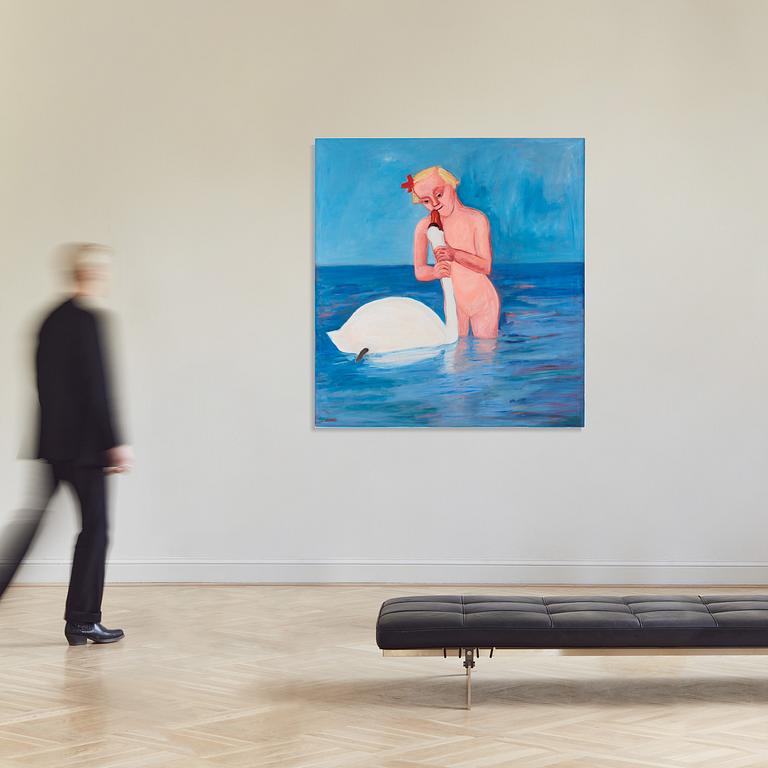Lena Cronqvist
'Flicka med svan'
Signed L Cronqvist and dated 1993. Oil on canvas 180.5 x 168 cm.
Provenance
Bukowski Auktioner, Moderna vårauktionen 515, May 2000, lot 434.
More information
At the beginning of the 1980s, girls appear as motifs in Lena Cronqvist's pictorial world, but it is mainly in the years 1990-1994 that little girls dominate the motifs. Usually it is not nice little girls that she depicts. At first glance, they may indeed resemble ideal images of children. However, they soon prove to be quite terrifying as they handle the various objects that have been slipping in and out of Cronqvist's paintings since the early 1970s. Like an echo from the past, memories, dreams and forbidden thoughts play out on her large canvases.
Cronqvist constantly returns to her childhood and the not entirely uncomplicated relationship with her parents and siblings. Her paintings of little girls are far from Carl Larsson's family idyll. They exude alienation, conflicted emotions and sometimes a recklessness that we don't usually associate with childhood. The canvases are filled with children: girls bathing, girls playing with dolls, girls trying to drown each other. They do all this without moving a muscle. Around 1993, Lena Cronqvist produced a number of unforgettable paintings of girls in water. The auction's painting 'Girl with Swan' creates an uncertainty about the child's mood: should the swan be strangled or given a kiss? Later, her girls also acquired a physical body when she started sculpting, the children were moulded in clay and bronze.
With curious eyes, Cronqvist's children explore the world without any adults present. Through innocent play, the child is moulded into the adult world, trained to handle social situations and relationships. It is in the borderlands of the psyche that Cronqvist moves with such skill. In her art, she has never avoided the taboo, but instead eagerly explores topics such as grief, anger, death and abandonment. Through her personal art, she gives us universal images in which we can all mirror ourselves.
Artist
Lena Cronqvist is born and raised in Karlstad. Her interest for the arts came early in her life, and she spent the first year of her studies in England, near Bristol’s Art School. Upon her arrival back in Sweden, Cronqvist began a short-lived education at Konstfack, leaving to study painting at the Royal Academy of Fine Arts. When examining Lena Cronqvist's painting, it delves into "painting" in its more traditional sense. She is indeed a painter in the grand modern tradition, frequently turning to Edvard Munch and Francis Bacon’s art as inspirational sources. Yet she also had numerous art historical references and a deep love for the craft. Cronqvist excelled as a colourist, finding harmony in the most unusual colour combinations – few have managed to paint warmth and cold successfully at the same time. Her subject matter is often perceived as challenging and overly private by many. She often models herself for her art, posing in mundane situations imbued with a sharp psychological character. Her “Modonna-pictures” from the 1970s are a good example of this. She turns our gaze away from the conventional, notably in her portrayal and depiction of girls, which is fascinating. Cronqvist depicts these girls as ugly, simple, and altogether uncomfortable – a great contrast to how woman were normally portrayed in art. In more recent years, Lena Cronqvist has studied the effect of aging, using herself as a study. Moreover, Cronqvist is a very successful sculptor, and several of her works in bronze have been sold great sums in the auction world. She is also gifted in graphic productions, of which “Strindbergsmappen” is the most well-known. Among her most renowned works is "The Betrothal," a paraphrase of Jan van Eyck's symbol-laden painting "The Arnolfini Portrait." In Cronqvist's reinterpretation, artist and husband Göran Tunström are the main characters, with equally weighty symbolism but carrying entirely different meanings. Where van Eyck's painting features a loyal dog, Cronqvist replaces it with a cat—a symbol of independence.
Read more

















































